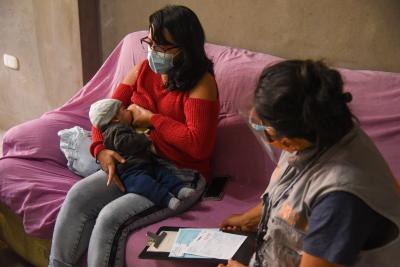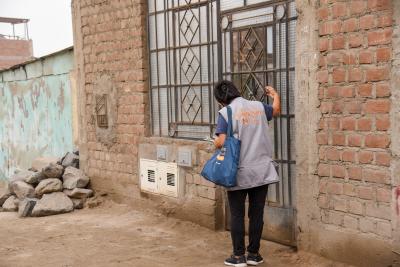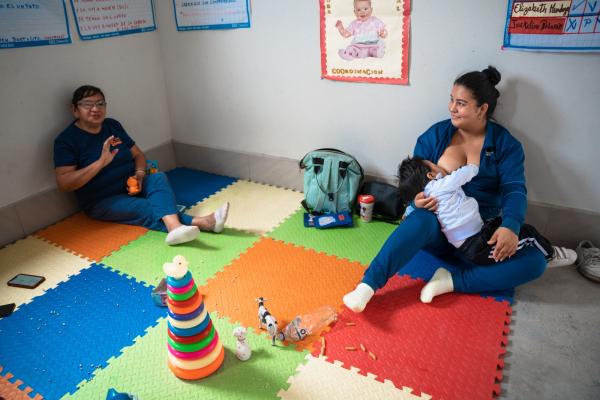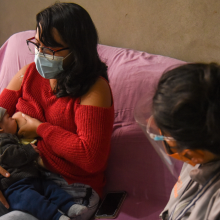“How long should I breastfeed my baby?”.
The question was repeated over and over again in the early stimulation educational sessions that Socios En Salud, through its Maternal, Infant and Adolescent Health (SAMIA) program, held in Pachacútec, a town in the district of Ventanilla. Some mothers thought that it was enough until six months of age, when the baby began to eat baby food. Others believed that it was enough to reach one year. In many cases, breastfeeding was interrupted early because of myths and misinformation.
But the evidence is clear: according to the World Health Organization (WHO), exclusive breastfeeding should be maintained until six months of age, and then continue -along with other foods- until two years of age or more. And is that this act, in addition to feeding, strengthens the immune system and helps reduce the risk of contracting common diseases, such as childhood anemia.
Following that pilot in Pachacútec, the SAMIA team fine-tuned its strategy. “During this year, each session with mothers focused on listening to and understanding their beliefs about breastfeeding. What barriers do they face to continuing breastfeeding? What do they know about its benefits?” says nutritionist Gerson Villarreal, project technician in the program.
The responses gathered allowed the program to refine its approach and strengthen its intervention in the CASITA VITAL project, funded by the Help Peru Foundation. In this new component, focused on improving hemoglobin levels in children aged 6 to 12 months in Ventanilla, the SAMIA team deployed a comprehensive strategy that includes breastfeeding counseling, micronutrient supplementation and the close accompaniment of nutritionists and Community Health Agents.

En su intervención CASITA VITAL, el programa SAMIA integró entre sus actividades la consejería nutricional la tarea de fomentar la lactancia materna exclusiva para disminuir el riesgo de desarrollar anemia infantil.
Foto de SES
Nutritional counseling in the face of worrying figures
The latest data from the Demographic and Family Health Survey (ENDES) 2024 show a slight decrease in the practice of exclusive breastfeeding in the country. 67.4 % of children under six months were breastfed in 2024, a figure that represents a drop of 1.9 percentage points compared to 2023 (69.3 %).
The regional gaps are also significant. While Pasco (88.5 %), Ucayali (83.7 %) and Cajamarca (83.4 %) have the highest levels of breastfeeding, departments such as Ica (45.8 %), Metropolitan Lima (54.1 %) and Lambayeque (57.3 %) show the lowest percentages.
Against this panorama, Socios En Salud has reinforced its work in vulnerable areas such as Pachacútec. Through the CASITA VITAL project, breastfeeding is promoted as an essential pillar within the nutritional strategy aimed at families with babies between four and six months of age.
“Counseling on exclusive breastfeeding is up to six months. After that age, complementary feeding is added, where it is necessary to incorporate iron-rich foods, since breastfeeding alone is not enough,” says Danna Obregón, a SAMIA program professional.
In 2024, there was a slight decrease of almost 2% in the practice of exclusive breastfeeding in Peru, with Lima, Ica and Lambayeque being the regions with the lowest percentages.
The specialist maintains that exclusive breastfeeding is addressed as a key issue in home visits. “We use a flipchart with clear and accessible information that our Community Health Agents (CHAs) use during home visits,” she details.
The approach is comprehensive. Accompanied by a nutritionist, the ACSs not only deliver information: they listen, resolve doubts and offer personalized support. “On each first visit, we talk about feeding and breastfeeding,” says Villarreal. “We check if the baby drinks only breast milk, if there is formula, if they have interrupted breastfeeding, and from there we give guidance.”
Thanks to this joint work, 66 mothers and caregivers received nutritional counseling last year, for which the ACSs and the nutritionist made 216 home visits in total. The goal: that each family feels accompanied to make informed decisions, strengthen the bond with their baby and protect their health from the first feeding.

En el periodo 2024-2025, las agentes comunitarias de salud del equipo de SAMIA que participaron en CASITA VITAL realizaron más de 160 visitas domiciliarias, mientras que el nutricionista del programa hizo más de 50.
Foto de SES
How does breastfeeding prevent infant anemia?
Anemia in babies under one year of age has multiple causes, but one of the most common is iron deficiency. Breast milk, although it does not contain large amounts of this micronutrient, offers a key advantage: its iron has high bioavailability, which means that the baby’s body absorbs it more efficiently.
According to the WHO, exclusive breastfeeding during the first six months contributes decisively to reducing the risk of anemia by promoting complete nutrition and strengthening the immune system. The Pan American Health Organization (PAHO) also stresses that initiating breastfeeding in the first hour of life improves newborn health in the short and long term.
More than 60 mothers and caregivers received nutritional counseling from the SAMIA team in the last year. In addition, community health agents and the project’s nutritionist made more than 200 home visits.
From his experience in the territory, nutritionist Gerson Villarreal adds: “In the case of breastfeeding, it does provide some iron, although not as much as other foods. That’s why, from the age of four months, babies receive a preventive supplement, since their reserves - accumulated since birth - begin to diminish.”
For the specialist, the focus should not be on a single element. “Breastfeeding helps cover part of the baby’s needs, but it is the joint work - between feeding, supplementation and constant accompaniment - that makes the difference.”
With sustained breastfeeding, timely iron supplementation and nutritional counseling, girls and boys have more defenses, less risk of anemia and greater chances of developing fully in their first years of life.
Do you want to know more about breastfeeding?
Check out this webinar organized by the Global Health Center of Socios En Salud, where Dr. Ana Muñoz Urribarri -a specialist in pediatric gastroenterology with more than 15 years of experience- explains the benefits of breastfeeding, resolves frequent doubts and debunks myths that still persist.
.




